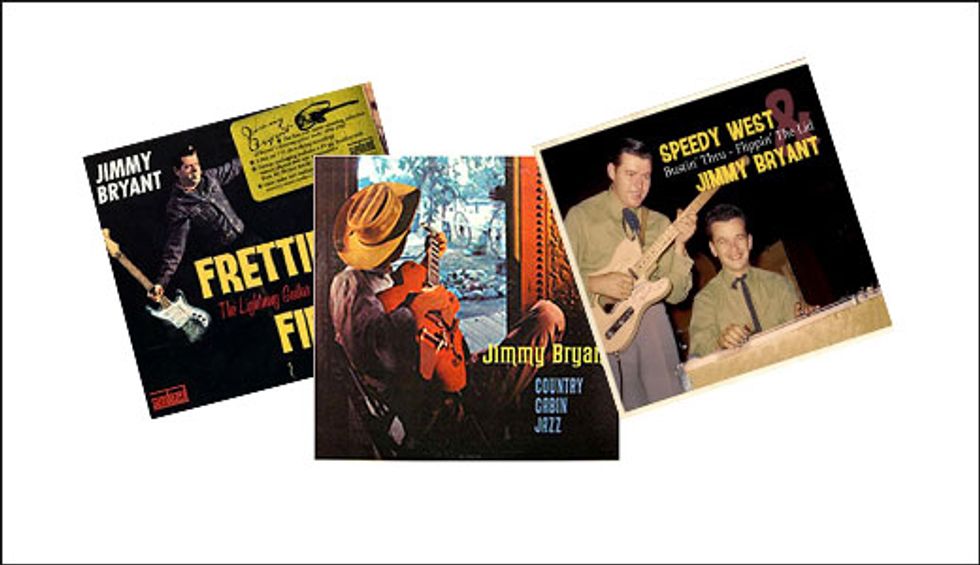Chops: Advanced
Theory: Intermediate
Lesson Overview:
• Weave spiky chromatic licks into your country solos.
• Discover how to incorporate augmented and diminished sounds into your phrases.
• Break out of pentatonic sounds by using pedal points, altered notes, and fast hammer-ons.
Click here to download a printable PDF of this lesson's notation.
Jimmy Bryant could be considered the first master of the Telecaster. Back when Leo Fender was developing the instrument, he gave the guitarist one of his early Broadcaster prototypes to get some feedback from Bryant, who ended up endorsing the guitar until the late ’60s. Much like the Telecaster, Bryant’s playing is beholden to no one style or genre, and maintains a strong personal sound and feel with a high level of proficiency and a signature harmonic sensibility. Bryant’s chops are second to none, and his improvising was a link between early jazz guitarists and country pickers.
Bryant’s primary creative outlet was a prolific collaboration with pedal-steel master Speedy West. Bryant and West released albums as a duo, and also backed up other artists. The songs Bryant recorded under his own name and with West were often built on simple chord progressions, yet the flashy licks he’d thread through them featured deeper harmonic references and fast chromatic passages.
In this lesson, we’ll focus on single-note lines that explore various harmonic and rhythmic motives that Bryant frequently used in his improvisations over I–IV–V progressions. Ex. 1 is based off the first lead break in the upbeat swing tune, “Jammin’ with Jimmy,” which introduces the song’s solo section. This lick is a great example of how Bryant would mix scale runs to steer between different harmonic ideas. The first measure of this lick runs up a G major pentatonic scale (G–A–B–D–E) and changes to a G diminished arpeggio (G–Bb–Db) over the IV chord, resolving to a bluesy lick in G.
Click here for Ex. 1
As exemplified in “Serenade to a Frog,” Bryant had a tendency to employ odd harmonies to create quirky melodies in his writing, and he’d also find ways to work this into his solos. He’d frequently use notes that are outside of the chord tones to extend the harmony of the chord progression and create tension.
In “Truck Driver’s Ride,” Bryant used a D# over an E7 chord to create an awkward tension against the chord. Ex. 2 starts there and uses a similar chord progression and movement to demonstrate this effect. In both the first and second measures, there’s chromatic movement between tones (approaching the E on the downbeat of measure two and approaching the D# on beat 4). Then, just when it sounds like a bluesy resolution, an E augmented arpeggio (E–G#–C) pushes over the E7 in measure three before resolving to A.
Click here for Ex. 2
Ex. 3 employs the same strategy Bryant used in his solo in “Crackerjack,” where he combines interesting rhythmic phrasing and note choices. It starts with a bluesy lick in E that lands somewhat surprisingly on a G natural. The lick then changes from a swing feel to straight eighth-notes in the last measure and uses fourths to resolve to the G# over the B7 chord, creating a B13. This juxtaposition of rhythmic feel and the use of fourths creates a quirky resolution.
Click here for Ex. 3
Ex. 4 continues in a similar fashion, but now rather than holding notes to create tension, we have a passage of faster notes. The second measure features a run comprising a pair of three chromatic notes, both starting at the fourth fret on the 2nd and 1st strings. This then resolves down a tritone to a two-beat phrase drawn from G Mixolydian (G–A–B–C–D–E–F).
Click here for Ex. 4
Bryant would frequently create tension by playing a chromatic line over static harmony or a pedal tone. There is a great example of this in Bryant’s solo on the song “Bryant’s Shuffle.” Ex. 5 shows one way to explore this kind of movement and create tension over a major chord. Check out how we move between the G, G#, A, and A# over the D before resolving diatonically.
Click here for Ex. 5
Bryant made a huge impression on listeners with his picking speed. He was one of the first blazing-fast electric pickers and he knew it—one of his records was titled Fastest Guitar in the Country. The next two licks could be considered as etudes for this type of playing. Practice them as slowly as necessary and gradually increase the tempo until you’re cruising along comfortably. Then, try using different note and rhythmic combinations in a similar fashion. The audio examples provided here are presented at a moderately quick tempo, but slow enough to hear the articulation and phrasing, though you can find examples of Bryant using these techniques at lightning speeds, as well.
Ex. 6 shows another repeated pedal-tone lick that Bryant would use, often at high speed. It’s shown here with triplets, but you can substitute sixteenth-notes for a more frenzied approach. This lick uses the root as a pedal tone; the chromatic line pops out, ascends from B all the way up to E, then resolves back down. Different fingerings can work for this lick, though it’s easiest to keep things on one string until the last measure.
Click here for Ex. 6
Finally, Ex. 7 shows a run like one Bryant played in the song “Stumbling.” It outlines a G major triad (G–B–D) using hammer-ons to move quickly through the pattern, followed by a rapid series of ascending and descending chromatic trills at the end of the phrase. For bonus points, see if you can adapt this technique to other arpeggiated chords.

















